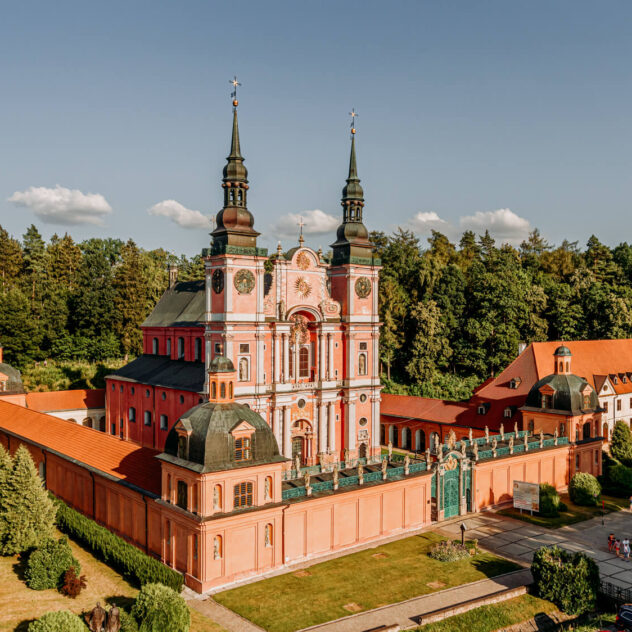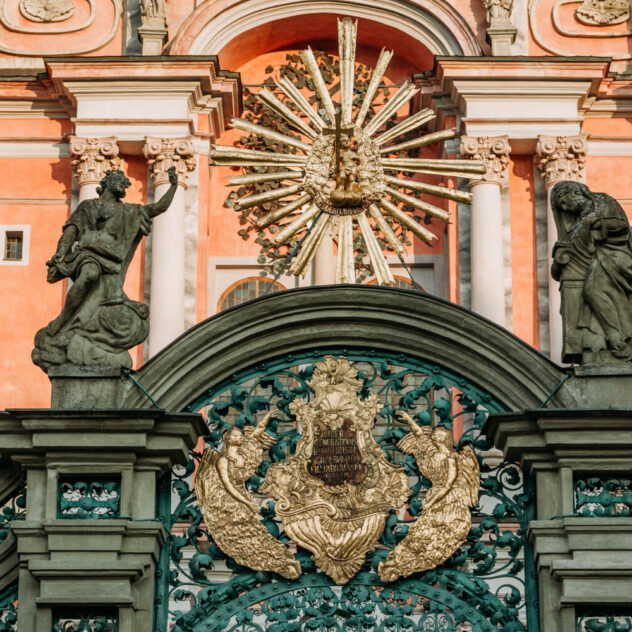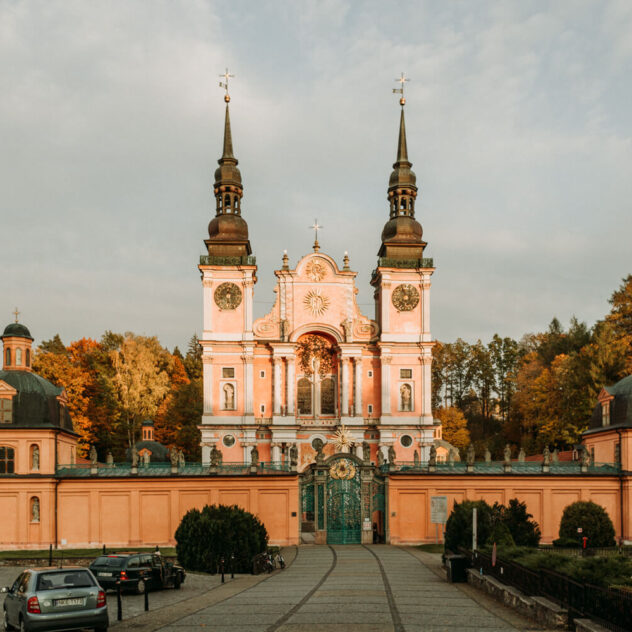Basilica of St. Mary in Swieta Lipka Basilica of the Blessed Virgin Mary in Święta Lipka
Information about the pilgrimage site
The shrine in Swieta Lipka was known practically from the beginning of Christianity in East Prussia. Its origins date back to the 14th century. According to folk tales, a certain convict imprisoned in the dungeons of the church in Kętrzyn was said to have carved a statue of the Madonna and Child in wood. When he was released from prison, he hung the statue on a linden tree by the road from Kętrzyn to Rzeszel. The statue soon became famous for its miracles, and the first chapel was erected by this lime tree, which was staffed by priests from the Teutonic Order. Swieta Lipka became a place of pilgrimage for the faithful from Warmia, Prussia and also from Mazovia. In 1519, the last Grand Master of the Teutonic Order Albrecht Hochenzollern made a barefoot pilgrimage to Swieta Lipka from Königsberg.
The time of the Reformation was a difficult period for the Catholic faith in the Prussian state. Catholicism was banned and the chapel in Svatá Lipka was robbed and demolished. The miraculous statue of the Virgin Mary was drowned in Lake Vortex and the linden tree on which it hung was cut down.
In 1618, Catholics regained their religious freedom in the Prussian lands. Thanks to the efforts of Stefan Sadorski, secretary to King Sigismund III, a new chapel was built in Swieta Lipka, placed under the care of the Jesuits. An image of Our Lady of Swieta Lipka, modelled on the Roman image of Our Lady of the Snows, was placed in the chapel. With the creation of the new chapel, the pilgrimage movement was revived. The arriving pilgrims soon stopped being able to fit in the chapel. Between 1688 and 1693, a Baroque temple was built, which still serves the faithful today. The richly decorated altars, the wrought-iron gate, the stone and wood carvings, the works of artistic smithery and ironwork make the sanctuary in Swieta Lipka one of the most splendid late Baroque churches in Poland.
The image of the Saintolipian Madonna was adorned with papal crowns. The solemn coronation was performed on 11 August 1968 by the Primate of Poland, Cardinal Stefan Wyszyński, together with Cardinal Karol Wojtyła, Metropolitan of Krakow. In turn, on 29 May 1983, on the feast of the Visitation of the Blessed Virgin Mary, the bishop of Warmia, Jan Obłąk, performed the solemn reading of the papal bull establishing the sanctuary as a basilica minor.
The main celebrations of the indulgenced feast take place on the last Sunday of May, when the faithful make their way to the sanctuary in a walking pilgrimage called “Star pilgrimage” from Reszel, Kętrzyn, Mrągowo, Giżycko and nearby parishes. On Fridays of the holiday period, “Swietolipskie Wieczory Muzyczne” are held in the Basilica.
Tourist attractions in the vicinity
Organ presentations – The Sanctuary is known for its exceptional organ presentations, during which one can not only listen to the unique sound of the organ, but also watch the moving figures. The Holyolip Music Evenings, organised in the Sanctuary during the summer season, are also extremely famous.
Castle of the Bishops of Warmia – in nearby Reszel, there is a castle of the Bishops of Warmia situated on the banks of the river Sajna. It was built between 1350 and 1401 and now houses a hotel, restaurant and Gallery of Contemporary Art, a branch of the Museum of Warmia and Mazury.
Teutonic Castle in Kętrzyn – is an example of Gothic architecture. Although it has been rebuilt many times over the centuries, it has not lost its unique character. Initially, it was a three-winged building with a well in the courtyard. At the turn of the 14th and 15th centuries, it was surrounded by a defensive wall with towers in the corners to the north, east and south. Around the 15th century, two gates with drawbridges were built into the wall, which were walled up in 1454 after the townsfolk conquered the castle. After 1525, the castle became the seat of the ducal aldermanship, and before World War II it housed the financial office and flats for officials. Currently it houses the Wojciech Kętrzyński Museum. More information: https://www.muzeum.ketrzyn.pl/
St. George’s Church in Kętrzyn – St. George’s Church was built in 1359-1407 and incorporated into the city’s fortification system. It is the best preserved defensive church in Masuria.
Castle in Bezlawki – a Gothic castle which was built in the 14th century. Initially it was the seat of a Teutonic bailiff, at the end of the 16th century it was rebuilt and converted into an Evangelical church. The castle is surrounded by a castle gate and a defensive wall, which later served as a fence for the cemetery located next to the church. Remains of the cemetery and some tombstones can still be seen today. Urban legend has it that the legendary Holy Grail, sought by King Arthur’s knights, was kept within the walls of this castle. Numerous lakes, hiking and cycling paths are also attractions.
Other tourist attractions near the pilgrimage site can be found on the website of the Warmia and Mazury Regional Tourist Organisation: https://wmrot.org/.
Accommodation
- Accommodation for pilgrims: Pilgrim’s House (https://www.swlipka.pl/dla-pielgrzyma/domy-pielgrzyma)
- Other accommodation in the nearest major towns: Kętrzyn and Reszel
Availability
By car
Getting there by car is the fastest way. Swieta Lipka can be reached from Kętrzyn on national road No. 594 and also from other directions in Poland.
By public transport
Swieta Lipka can be reached by bus from Kętrzyn and from Reszel. The drive from Kętrzyn takes about 20 minutes, from Reszel about 10 minutes. The sanctuary is about 3 minutes from the bus stop.
On foot
According to current tourist maps.
On a bicycle
According to current tourist maps.








